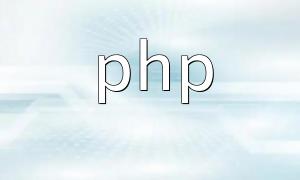Application and Common Issues of UTF-8 Encoding in PHP Development
With the globalization of the internet and the development of multilingual environments, UTF-8 encoding has become a universal character encoding that plays a crucial role in PHP development. UTF-8 not only solves issues of character display and transmission in multiple languages, but is also compatible with various operating systems and browsers. This article will delve into the application of UTF-8 encoding in PHP, along with common encoding issues and their solutions.
Characteristics of UTF-8 Encoding
UTF-8 is a variable-length encoding of the Unicode character set that can represent almost all the world's characters and symbols. Its main features include:
- Variable-length encoding: Each character occupies 1 to 4 bytes, offering flexibility and effectively saving storage space.
- ASCII compatibility: UTF-8 is compatible with ASCII encoding, ensuring that ASCII text is processed without issues.
- Supports multiple languages: UTF-8 can handle characters from almost all languages, including Chinese, Japanese, Arabic, and more.
Applications of UTF-8 Encoding in PHP
In PHP development, UTF-8 encoding is widely used across several areas. The following are common application scenarios:
- String Processing: PHP’s built-in string functions (e.g., strlen(), substr()) support UTF-8 encoded strings, making string manipulation with UTF-8 easy for developers.
- Database Storage: When using MySQL, it is essential to set the database character set to UTF-8 to avoid issues when storing non-ASCII characters.
- Form Submission: For web forms, ensuring PHP correctly processes UTF-8 encoded data is critical. This can be achieved by setting the appropriate HTTP header (Content-Type).
- File I/O: File reading and writing operations should specify the UTF-8 encoding to ensure the accuracy and compatibility of the file content.
Common Issues with UTF-8 Encoding in PHP
Despite its widespread use, UTF-8 encoding may still encounter some issues during implementation. Here are common problems and their solutions:
- Garbled characters: When the PHP file encoding does not match the browser or database character set, garbled characters may appear on the page. This can be solved by setting the correct encoding in PHP with the header() function: header('Content-Type: text/html; charset=UTF-8');
- Database storage issues: To avoid storing data incorrectly in MySQL, ensure that the database character set is set to UTF-8. This can be fixed by modifying the character set of the database table.
- String truncation: Due to UTF-8's variable-length encoding, using the substr() function may result in incorrect truncation. To avoid this, use the mb_substr() function to correctly handle UTF-8 encoded strings.
- Form data processing: When form data includes Chinese or other special characters, issues may arise due to encoding mismatches. This can be resolved by using the mb_convert_encoding() function to convert the encoding.
- File I/O issues: When reading or writing files, ensure that the file encoding is set to UTF-8 to avoid garbled text. Use the fopen() function to open files in UTF-8 mode.
Conclusion
Correctly handling UTF-8 encoded data is essential in PHP development. Through this article, we have explored the applications and common issues related to UTF-8 encoding in PHP, and provided solutions for problems such as garbled characters and string truncation. By ensuring encoding consistency, we can effectively handle data from various languages and character sets, improving both development efficiency and system compatibility.









